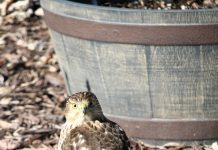In pocketed garden plots dotting five hilly acres, leafy clumps of decorative plants poke through new mulch.
Deep green Pacific Sunrise hostas, with leaves rimmed in neon hues, grow in one section of the garden of Janet Hommel Mangas. Nearby, the massive heart-shaped leaves of the Blue Angel hosta provides a shady stand of cover.
Fantastically named varieties such as Bodacious Blue, Sleeping Beauty and Tickle Me Pink all help create a uniform yet unique looking garden.
“I like the look of them — almost tropical,” Mangas said. “And they’re really easy to grow. You almost can’t mess them up. I bring them home and plant them.”
As the leafy green cover crops that fill out a garden, hostas can get lost by the flashier, more colorful and more exotic plants in the garden. But the hardy, easy-to-grow and increasingly varied hosta can carry a garden entirely on its own.
Thanks to hybridization efforts, many centered in Indiana, the capability and popularity of the plant is expanding.
Enthusiasts eager to learn more about the plants will have the chance to tour 12 of the best-designed hosta gardens in central Indiana, including Mangas’, at a two-day event hosted by the Indianapolis Hosta Society.
“This is an integral part of the hosta society, and every year we have tours of two or three gardens to let the broader club come in and see what they’ve done,” said Andrew Russell, president of the society. “Every garden is different.”
Hostas are originally native to Asia, growing in forests throughout China, Japan and Korea. In the 1700s, the plant was brought to Europe for inclusion in gardens. The hosta made its way to the U.S. in the 19th century.
While the plants can certainly serve as a garden centerpiece, they also blend in with other perennials, annuals, trees and shrubs.
“Many people are into the aesthetics. Hosta plants are partial shade plants, so there’s a big thing to developing the landscape to accommodate other perennials that grow in the shade,” Russell said. “They can be very beautiful together.”
Mangas has always had an interest in gardening but only became interested in hostas in the last eight years.
“I’ve always liked to get my hands dirty. Taking care of these is calming and peaceful and a great chance to be outside,” Mangas said.
The main benefit of the hosta is how easy it is to grow.
The plant tolerates and in most cases thrives in shade. They don’t need to be pruned or shaped, and are tolerant to the wet-and-dry conditions of Indiana seasons.
Mangas pointed to a specific point in her garden to illustrate the point. At the end of the growing season last year, she was mostly finished planting her hostas for the coming year.
One she had left over, she just plopped it on a rock next to a creek bed. Despite that, it has blossomed and bloomed this year.
“I hardly did anything to it. It’s still down there — I haven’t moved it. And it’s beautiful,” she said. “They’re pretty durable.”
She and her husband Steve grow more than 130 varieties of hosta on their White River Township property.
Spread across five acres, they have created a whimsical series of gardens throughout their White River Township property. With numerous trees dotting the rolling hills around their house, each garden plot has the shade needed to grow a variety of hostas.
That’s not to say hostas are invincible, Mangas said. Voles snack on the root system of the plant, and can wreak havoc on an entire stand of hosta if left alone.
Also, avoid planting hostas near a silver maple. Silver maples have surface roots, and they’ll choke out your hostas, Mangas said.
Only in the past 50 years, though, has use of hostas in gardening become popular. Horticulturists have developed an ever-expanding range of hybrids and mutations that have given the plants radiant color, bizarrely large size and unique leaf shape.
Indiana has become a center of hosta innovation and growth. Nearly 20 hybrid growers are operating in Indiana, playing with the breeding to alter the size, color, shading and leaf shape.
[sc name=”pullout-title” pullout-title=”Indianapolis Hosta Society Garden Tour” ]
[sc name=”pullout-text-begin” ]
What: A showcase featuring creative and beautiful use of hostas in 12 gardens throughout the Indianapolis area, including that of Steve and Janet Hommel Mangas in White River Township.
When: 11 a.m. to 5 p.m. June 11 and 12
Where: Location maps will be provided when tickets are purchased. The tour is self-guided over the course of two days.
Cost: $20 per person
How to buy tickets: indianapolishostasociety.org








